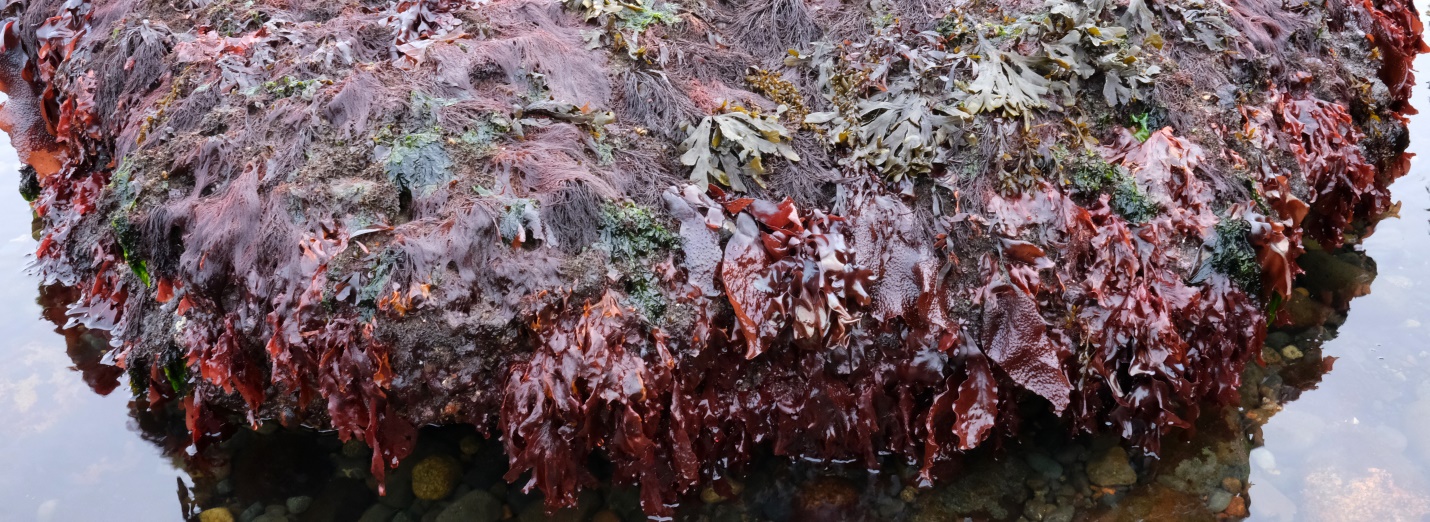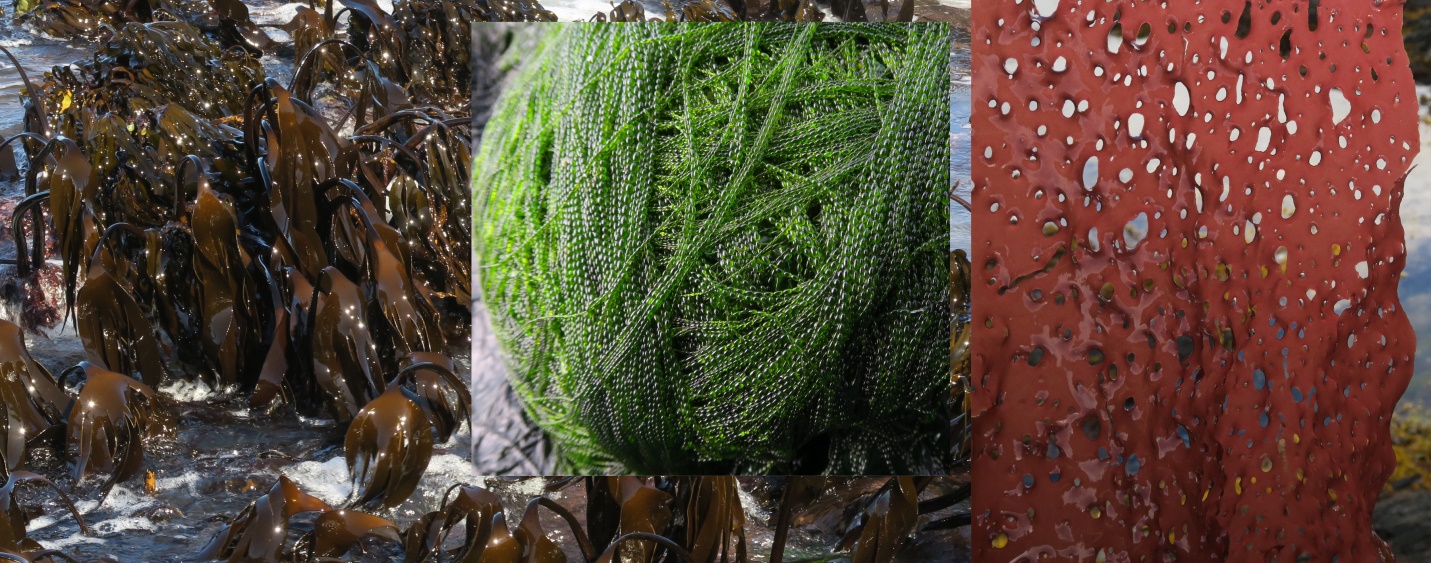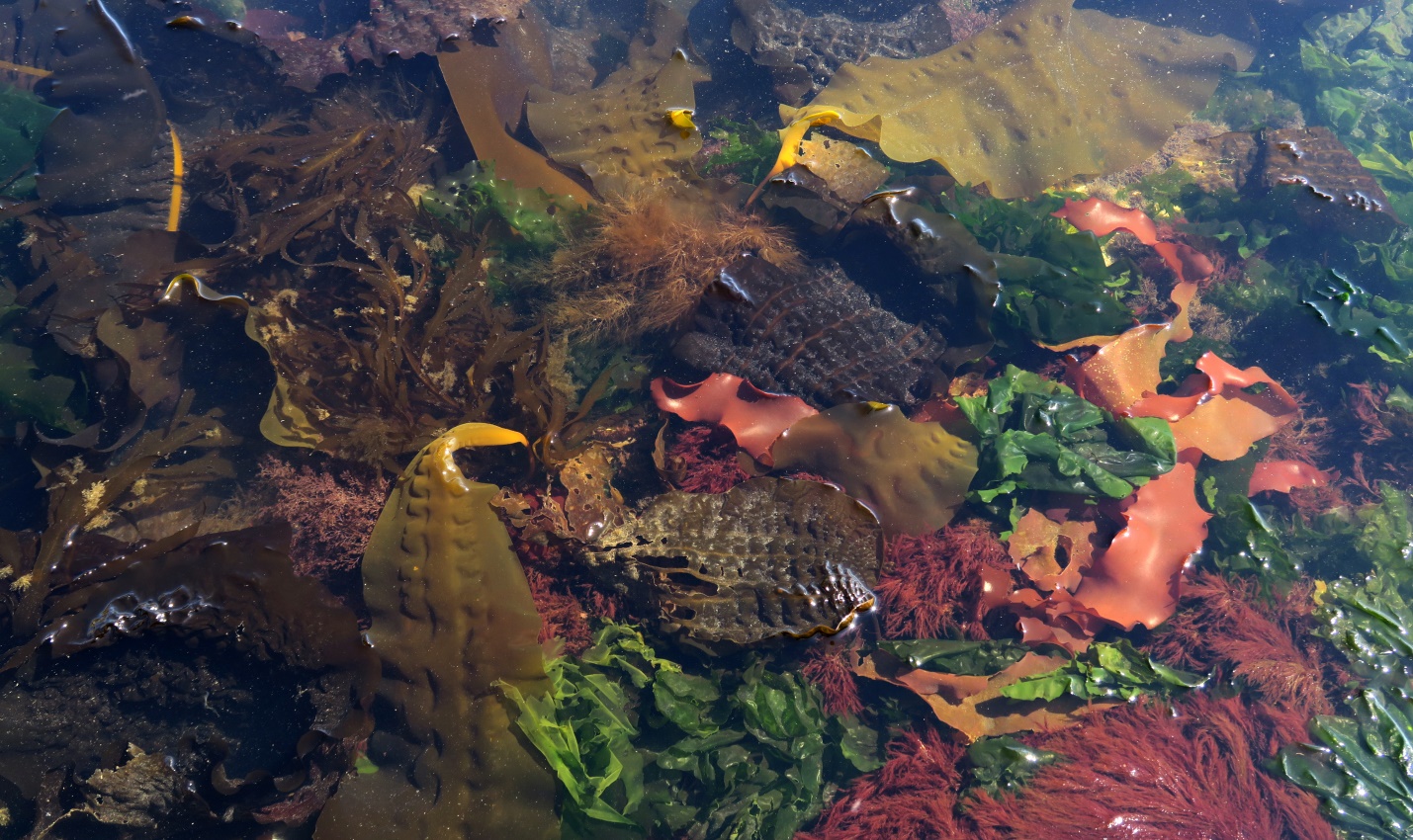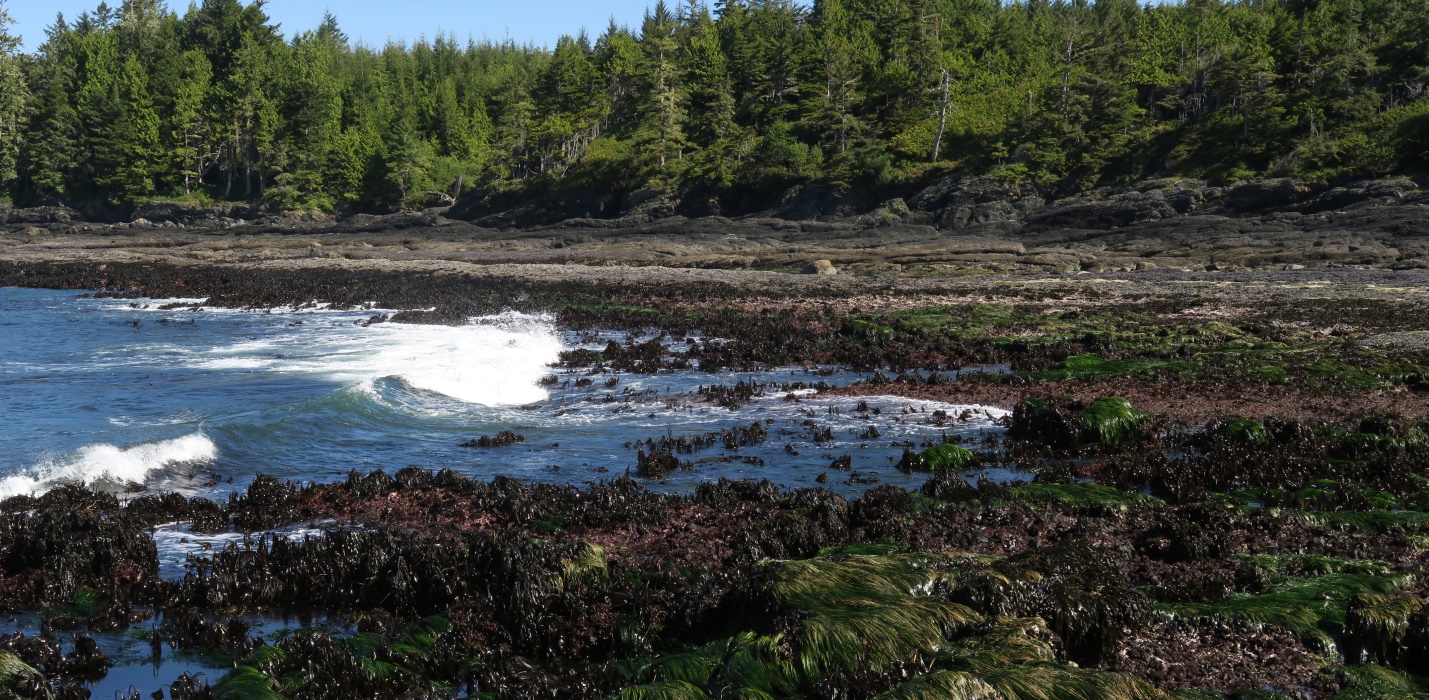
Introduction
In the past few years it has been our great pleasure to have made many excursions down to the seashore to spend some time among the seaweeds. Matching our pace to the cycles of the tides, we learned their names and how to identify them, began to understand how and where they grow. It’s a fascinatingly colorful and morphologically diverse group of organisms – the macroalgae!
It didn’t take long to understand that the seaweeds have something to say. We found that if we opened our senses and listened carefully there is wisdom that they generously share. These ‘Whisperings’ are a representation of that.
There are words and there are photographs. If you can’t go down to the seashore yourself to be with the seaweeds, then the images are presented here in the hope that they may enhance your own ‘conversation’ with the individual species and also to aid in your understanding of the words that we found to express what we heard from the seaweeds ourselves.
We invite you to immerse yourself. Seaweeds whispering, humans listening – where might that lead?

Figure 1 (Photo at top of page): Land meets sea – and seaweeds abound! Strait of Juan de Fuca, B.C., Canada. Photo ID: 27138 ©Seaweedwhisperings.com
Figure 2: A boulder teaming with life as only seaweeds live it! Red algae show prominently but greens and browns are also present; Point Holmes, Strait of Georgia, B.C., Canada. Photo ID: 27120 ©Seaweedwhisperings.com
Conservation Imperative:
As persons who have been rewarded so richly through our interactions with the seaweeds in their natural habitat, we feel compelled to extend a plea for careful, continued and even increased conservation efforts. As we explore among the seaweeds we take care to tread as gently as possible, sample very little if anything at all, and take away only photographs and remarkable memories. In our interactions we have learned that the life of the intertidal zone, and notably the macroalgae, consistently and generously respond to this respectful behavior and give back in kind. If you are reading this website with interest the probability is high that safeguarding the earth’s wild life is already something of importance to you. Preservation of marine estuaries, intertidal habitats and such ecologically significant realms as the kelp forests of the world’s nearshore waters, indeed the ecosystem of the earth’s oceans as a whole, becomes an even stronger imperative the more one comes to know and appreciate the outstanding life expression that is the marine macroalgae themselves!
Citing This Work:
Kindly note and please respect that the Whisperings and photographs on this website are original work. They are copyrighted to ©Seaweedwhisperings.com.
While we hope that you may be informed and even inspired by the content of these pages, if you choose to share, copy, reproduce or distribute this material, we ask that you cite us as follows:
https://www.seaweedwhisperings.com; searched on “date of viewing” e.g. April 28, 2022.
We
have thought carefully about including an email address as we want
this website to be an information source for people who choose to
read the Whisperings, and we do not have time to engage in
discussions with users about what is written. However, if you have
personal observations about your interactions with any of the listed
seaweeds that might enhance ours and others understanding, we would
be interested in hearing from you. The expectation is that this site
will continue to grow as more seaweeds are listened to and other
updates may also occur. If you do send an email to
![]() do not expect a rapid response as we will be checking the account at
irregular and well spaced intervals, but hopefully at least once a
month. We reserve the right to delete and ignore emails that feel
misaligned with the intent of this website which is to share
the Whisperings of seaweeds with as many people as possible.
do not expect a rapid response as we will be checking the account at
irregular and well spaced intervals, but hopefully at least once a
month. We reserve the right to delete and ignore emails that feel
misaligned with the intent of this website which is to share
the Whisperings of seaweeds with as many people as possible.
Some Basic Information and Terminology
Seaweed is a colloquial term for marine macroalgae. Other algae exist, but our explorations have been with the macroalgae that live in the nearshore marine environment.
Phycologists – scientists and other experts that study seaweeds, have divided them into three main groups:
Brown (class Phaeophyceae in phylum Ochrophyta)
Green (Chlorophyta)
Red (Rhodophyta)

Figure 3: (Left to right) Laminaria setchellii (Southern Stiff-stiped Kelp) and Lessoniopsis littoralis (Strap Kelp) representing the brown algae; Urospora wormskioldii (Jade Necklace) for the green; Sparlingia pertusa (Red Eyelet Silk) as an example of the red; all date from May 2021. Photo ID: 27122 ©Seaweedwhisperings.com
Seaweeds are photosynthesizing organisms – they transform sunlight into chemical energy. They all possess chlorophyll but in the reds and browns there are pigments that mask the green chlorophyll.
Seaweeds in some ways resemble plants but they are more ancient in terms of evolution and have simpler features. They lack the complex roots, stems, branches, leaves and flowers of most land plants. They do have analogous structures that perform similar functions; these seaweed ‘structures’ do look distinct, but they mostly lack differentiated tissues.
Basic structural terms are:
thallus – the entire seaweed (plant), the algal body
blade – the leaf-like structure, often flattened
midrib – the mid vein
stipe – the stem-like structure (connecting the blade to the holdfast)
holdfast – a root-like structure that attaches the seaweed to the substrate
pneumatocyst – air bladder/floatation assistance organ
sorus/sori – spore cluster(s)
haptera – finger-like extension of some types of holdfasts
Some seaweeds are comprised of a chain of single cells that to the naked eye look like nothing more than a strand of hair, a simple thread or filament. Other seaweeds have adapted to meet the environment in which they’ve evolved by taking quite different forms indeed. There are branching patterns in these macroalgae that are complex and exquisitely intricate, and in others, if there is a pattern to be found, it can be very simple, even crude, or random and quite irregular. Observing these branching patterns can be very helpful in identifying seaweeds, and the basic structures – type and length of stipe, shape and texture of holdfast, form of any pneumatocysts present, even alternating forms of the entire thallus between crust and foliose, well, this is all to say that the basic structures have many variations and combinations so seaweed shape and morphology can be astonishingly diverse as well as colorful.

Figure 4: A ‘spring garden’ of seaweeds in their element – at least eleven different species are present in this small area of Gonzales Bay, Juan de Fuca Strait, B.C., Canada. April 17, 2021. Photo ID: 27123 ©Seaweedwhisperings.com
Where Seaweeds Grow
The dynamic world of the nearshore marine environment, from high up at the supratidal area (the zone of the tidal region that lies above the mean high water for spring tides; this region is inundated only occasionally by exceptional tides or by tides augmented by a storm surge) down to the low light subtidal depths (many easily as deep as 30 meters and some rare species even deeper) is the realm of the marine macroalgae. Tidal cycles, type, size and structure of substrate, and wave exposure also influence what species of macroalgae can thrive and where. Some species can thrive in sheltered mud or sandflats, whereas others thrive only on rocky outcrops exposed to the toughest of winds and ocean swells.
Survival in the intertidal zone presents numerous challenges and stressors for seaweeds. To survive, let alone thrive, they must have adequate sunlight to grow, they must be able to tolerate huge forces from waves, they must be able to endure exposure to air and temperature changes (both freezing and hot) that vary greatly from their ambient water temperature, they must compete for suitable habitat, repel or defend against predation by herbivores, and of course, they must also successfully reproduce. Relative to their access to light in their watery environment, seaweeds actually utilize sunlight more efficiently than terrestrial plants and they play a vital role ecologically in capturing carbon, producing about 50% of the planet’s oxygen.
As we have spent time interacting with and learning about them, we have found that seaweeds are admirably well adapted and successful in fulfilling their life functions and ecological role. They have chosen a tremendously challenging niche in which to live and they have mastered it! Phycologists have learned that seaweeds are among the most complex and varied of life forms regarding their life histories and reproductive strategies; this fact is a bit surprising but indeed is characteristic. Another characteristic is that as photosynthesizing organisms seaweeds are restricted to the light-penetrating zones of the world’s oceans. In general one could say that the reds will be found in the regions of lowest light, so most will grow mainly in subtidal regions down to an average of about 30 meters below sea level and with some ranging to 100 meters (there are a few exceptional species that live as deep as 295 meters in the clear tropical waters of the Bahamas). The greens are often found in shallow water or in the higher tidal or even supratidal areas; many of them are annuals and can quickly take advantage of new substrate when it becomes available. Many of the brown seaweeds have a kind of in-between position, with their holdfasts low on the ocean floor and their blades floating at or nearer to the surface where light exposure is excellent.
In our region, the coastline of the Pacific Northwest of North America, we have found that browns, mainly the kelps, are well-known to the interested beachgoer and are amongst the easiest seaweeds to recognize and identify. Greens can get a bit tricky, and the reds…., well, most of the species we work the hardest to confirm identification of are among the reds! The reds also have the highest number of species worldwide – an estimate of over 7,200. The greens number at about 1,800 species and the browns measure in at about 2,000 species globally.
Many, many marine life forms, birds and even mammals find seaweeds to be a vital resource. We’ve found that the low tides never can quite last long enough, as our time spent with the seaweeds is not only teaching us much, it is also beautifully revitalizing. Seaweeds are a fascinating group of organisms to study. In the references page we cite many wonderful resources. These experts all share a passion and appreciation for seaweeds – if you want to know more, then you will do well to explore further with both the seaweeds in their habitat and these sources.

Figure 5: The Pacific Ocean swells refresh the intertidal zone at Botany Bay on a spring low tide day; Juan de Fuca Strait, B.C., Canada. May 29, 2021. Photo ID: 27124 ©Seaweedwhisperings.com
![]()